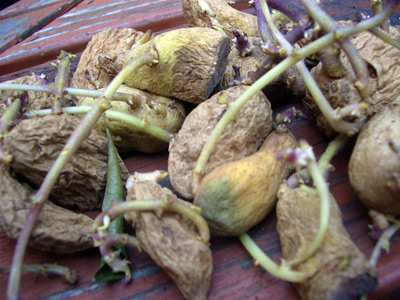Would a handful of sprouters grow just as well in a bucket in Bernal Heights? After all, if Love Apple Farm's potato buckets were good enough for David Kinch, wouldn't a plastic pot do just fine for me? (Cynthia Sandberg must know her stuff; her tiny Love Apple Farm is a kitchen garden whose kitchen just happens to be Kinch's restaurant Manresa.) The process is simple: in a large, deep bucket, lay the sprouting potatoes (each piece, or potatoes, containing at least a couple of eyes) on a layer of soil about four to six inches deep. Cover with another couple of inches of soil. Water in until soil is moist but not soggy. Sit back and wait. When the potatoes have pushed a leafy stem up about 4 inches above the soil, fill in with more soil, covering the stem to just below the top leaves. Continue the grow-and-cover process until you reach the top of the bucket.
And what better time to plant than right around St. Patrick's Day? It's easy to remember, after all, and the closeness to the spring equinox in our climate pretty much ensures frost-free nights from now on. A beautifully informative essay on the role of potatoes in rural Irish life can be found in John Thorne's Pot on the Fire; at the end of the chapter he has recipes for both champ and colcannon, two easy dishes of greens (which could be foraged) and potatoes (homegrown), both of which make delicious vegetarian alternatives to the typical corned beef & cabbage.
For champ, peeled potatoes are boiled, drained, and pummeled to smoothness. While the potatoes are boiling, tender spring greens--nettles, spinach, turnip or radish tops--are gently simmered in milk. The greens (and the milk) are tipped into the potatoes and vigorously stirred together. A bowlful with a pat of butter makes a meal.
Colcannon uses slightly tougher greens, like kale and cabbage, and the mixture is stiffer, made firm enough to pat into a flat, thick pancake in a skillet and fry in butter until both sides are crisped up and lightly browned. (You can find boxty, an equally filling Irish potato cake, on the menu at The Liberties at 22nd and Guerrero Sts in the Mission, even if they do California it up with roasted red peppers and feta cheese.)
No plans for a champ-cam trained on the potato bucket yet; after all, most of the action during the next few months will be happening underground. But until then, you can browse the greens reappearing from the earth and dream of harvesting your very own patio potatoes.
